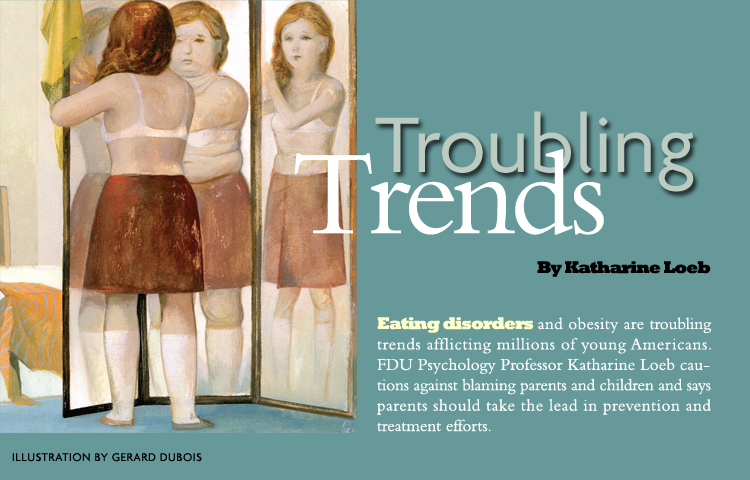 ating disorders, including anorexia nervosa and bulimia nervosa, typically begin in adolescence, and they often begin secretively. By the time parents or pediatricians notice their signs and symptoms, a pernicious pattern may have already developed, requiring special treatments.
ating disorders, including anorexia nervosa and bulimia nervosa, typically begin in adolescence, and they often begin secretively. By the time parents or pediatricians notice their signs and symptoms, a pernicious pattern may have already developed, requiring special treatments.
While eating disorders are often related to extreme patterns of dietary restriction, obesity, which is not classified as an eating disorder, can occur when intake exceeds the body’s nutritional requirements. Pediatric obesity, considered a growing epidemic in the United States (rates have tripled in the past 30 years, with nearly 20 percent of youth now obese), is more readily identified by others than eating disorders, often to the point of teasing and bullying.
Parents frequently tell me that they feel they walk a tightrope in trying to simultaneously prevent both eating disorders and obesity in their homes. When their efforts to create a balanced, healthy family lifestyle appear to backfire, and an eating or weight disorder develops in their children, they often blame themselves for the problem.
In promising research I am undertaking with colleagues and graduate students, we are developing and testing treatments for youth with eating disorders and obesity. These treatments focus on the family — not as the source of blame for the problem, but as the best resource to effect positive changes in health behaviors in children and adolescents.

 norexia nervosa is characterized by emaciation, active refusal to maintain a normal body weight, extreme fear of gaining weight or becoming fat, disturbance in the experience of shape and weight, denial of the seriousness of one’s low body weight and physiological consequences of starvation such as loss of menstruation.
norexia nervosa is characterized by emaciation, active refusal to maintain a normal body weight, extreme fear of gaining weight or becoming fat, disturbance in the experience of shape and weight, denial of the seriousness of one’s low body weight and physiological consequences of starvation such as loss of menstruation.
Some individuals with anorexia nervosa binge eat and purge (i.e., self-induce vomiting or misuse laxatives). These are also the cardinal features of bulimia nervosa, in addition to excessive influence of shape and weight on one’s self-evaluation.
Eating disorders disproportionately afflict females. While anorexia nervosa and bulimia nervosa collectively affect a small percentage (about 3 percent) of the adolescent population, other forms of these disorders are much more prevalent. These can be as serious as their full-blown counterparts in terms of medical and psychiatric consequences and, among adolescents, can represent emerging cases of the disorders.
Early intervention is the key to preventing the progression to a more severe eating disorder or to a chronic, relapsing course of illness. For example, over time, approximately 10 percent of individuals with anorexia nervosa die. Only half of these deaths are from medical complications secondary to starvation; half die by suicide, a tragic result of the depression so common in eating disorders.

 ating disorders have complex origins. There is no single, identifiable cause of anorexia nervosa or bulimia nervosa, and more research is required to understand the complex interactions between the various forces (personality, biology, genetics, environment) at play in determining who develops an eating disorder and who does not. What the field does know is that studies have failed to support the classic assumptions about a direct and singularly causal link between poor parenting and the development of anorexia nervosa or bulimia nervosa.
ating disorders have complex origins. There is no single, identifiable cause of anorexia nervosa or bulimia nervosa, and more research is required to understand the complex interactions between the various forces (personality, biology, genetics, environment) at play in determining who develops an eating disorder and who does not. What the field does know is that studies have failed to support the classic assumptions about a direct and singularly causal link between poor parenting and the development of anorexia nervosa or bulimia nervosa.

 ur research program builds on a seminal set of studies introduced more than 30 years ago examining the role of the parents in the treatment of anorexia nervosa and bulimia nervosa. This family-based treatment (“FBT”) — originally developed at the Maudsley Hospital in the United Kingdom and frequently referred to as the “Maudsley Method” — is an extremely effective alternative to hospitalization for children and adolescents with eating disorders.
ur research program builds on a seminal set of studies introduced more than 30 years ago examining the role of the parents in the treatment of anorexia nervosa and bulimia nervosa. This family-based treatment (“FBT”) — originally developed at the Maudsley Hospital in the United Kingdom and frequently referred to as the “Maudsley Method” — is an extremely effective alternative to hospitalization for children and adolescents with eating disorders.
FBT enlists the parents as the primary agents of symptom reversal in their child, taking a view that food is medicine, with the “dosage” (quality and quantity of food) a function of the patient’s level of starvation or degree of dietary restriction, and a regular pattern of eating (i.e., three meals per day plus snacks) reflecting the “dosing schedule.” Parents initially take on the role of a hospital staff, e.g., supervising all nutritional intake and, as applicable, helping a child at risk of purging avoid the bathroom immediately following meals.
Several factors sustain parents and increase the likelihood of success in FBT. These include parents’ love for their children and children’s desire to have parents not give up hope.These procedures rely on a blend of firmness and empathy (no punitive techniques allowed), avoid casting blame and emphasize that autonomy over food will be transferred back to adolescents when symptoms abate.
next …










